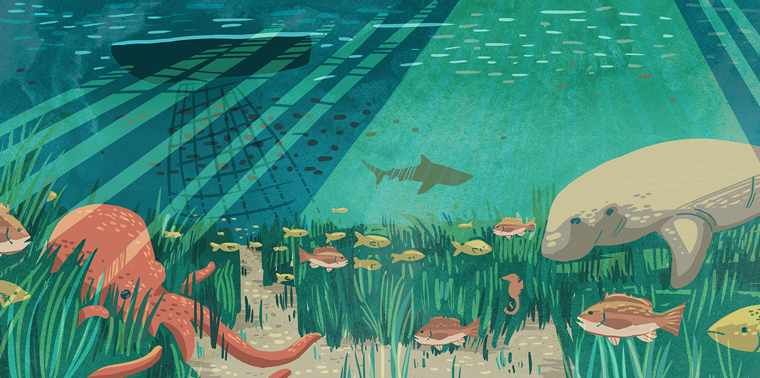February 25, 2018 — Protecting the health and productivity of our oceans remains one of the biggest challenges facing humanity in the coming century. The future of our climate and food supply depends on it. But much of our efforts are currently misplaced. Instead of focusing on species and habitats potentially doomed by changing climate, we should target our research and conservation where it can make the biggest difference. If we are to protect many of the important roles the oceans play we need to take up the cause of seagrass meadows — some of the most important, vulnerable and ignored ecosystems in the world.
Significance of Seagrass
Seagrasses are plants adapted to live underwater where they form large meadows. Such meadows can sometimes be tens of kilometers in size. These grasses (related to terrestrial lilies rather than true grasses) have shoots and leaves above the sediment that can range from small, 1-centimeter (0.4-inch) paddlelike structures to long thickened leaves that are over a meter (3 feet) in length.
As major carbon stores, seagrasses help stabilize our climate, and damaging seagrass directly releases carbon dioxide stores into the atmosphere. Recent research has also demonstrated that seagrasses are highly efficient at removing pathogens and pollutants from the water column.
Seagrass meadows attract many different types of animals, to live, forage or seek shelter. For example, in the tropics many species of snapper spend critical times of their life cycle living in seagrass. In temperate climes this is also the case for species such as the Atlantic cod. In a recent global study, my colleagues and I determined for the first time that humans use these diverse and productive animals for food and for commercial and recreational purposes all around the world. From the remote Pacific islands to the coastline of Wales, where there are seagrass and people, there is fishing.
In the coastal communities of developing countries, the importance of the nearshore seagrass fishery for livelihoods and well-being is irrefutable. We discovered that a wide range of fishing methods and gear are used, from intertidal (accessible by foot) to relatively deep water seagrass (where commercial trawls can operate). The study found that seagrass meadows are multispecies fishing grounds targeted by fishers for any fish or invertebrate species that can be eaten, sold or used as bait. In the coastal communities of developing countries, the importance of the nearshore seagrass fishery for livelihoods and well-being is irrefutable. In developed countries, the seagrass fishery is often recreational and/or more target species–specific.
Threats
Yet both seagrass and the fish that live in them are being lost at an accelerating rate. Because seagrasses are shallow nearshore marine habitats, they are at the forefront of how human activities on land are impacting our oceans. Everything from coastal development, to boating and deforestation is putting seagrasses at risk. In 2009, global experts estimated that as much as two football (soccer) pitches worth of seagrass were being lost each hour, and these figures require updating. Such loss is similar to (if not higher than) that faced by coral reefs and rainforests.
Many fisheries associated with seagrass are unrecorded, unreported and unmanaged, leading to a “tragedy of the seagrass commons.” Too many fish are being caught at too young an age, often using gear that damages the habitat and leads to high bycatch.
Although some examples have surfaced of healthy seagrasses, the global evidence continues to suggest that seagrasses are being damaged around the globe.
Proposal: Reprioritize
With the right efforts a bright future for seagrass can exist. The problem is, funding for ocean conservation is limited. And right now, it is focused far more heavily on more charismatic habitats and species such as coral reefs.
Although such investments can be argued from a short-term biodiversity perspective, evidence suggests that local conservation protection is probably insufficient to maintain coral reefs’ long-term viability without global climate action. With finite marine conservation resources available, we need to change our focus of what we protect to consider the long-term needs of humanity. Marine conservation efforts must turn toward seagrass meadows in order to protect this vital source of food security.
We know that investments in reversing catchment degradation, enhancing seagrass marine protected areas, and developing education programs about seagrass can result in lower levels of seagrass disturbance and ultimately improved seagrass condition.
Those responsible for making large scale global marine conservation funding decisions need to take a hard long look at where their priorities lie and the long-term cost-benefit of these decisions. Fisheries problems, for their part, are largely manageable at a local or regional level. Fisheries management actions, such as the use of minimum fish size, protected areas or the use of prohibited seasons, have been proven to protect the fisheries of other nearshore marine habitats. Such approaches need to target seagrass meadows as well.
Those responsible for making large scale global marine conservation funding decisions need to take a hard long look at where their priorities lie and the long-term cost-benefit of these decisions. Seagrass meadows urgently need to hit the marine conservation agenda so they continue to help support global food security and contribute to absorbing the growing levels of carbon dioxide in our atmosphere. ![]()
Editor’s note: The views expressed here are those of the author and not necessarily of Ensia. We present them to further discussion around important topics. We encourage you to respond with a comment below, following our commenting guidelines, which can be found on this page. In addition, you might consider submitting a Voices piece of your own. See Ensia’s Contact page for submission guidelines.
Ensia shares solutions-focused stories free of charge through our online magazine and partner media. That means audiences around the world have ready access to stories that can — and do — help them shape a better future. If you value our work, please show your support today.
Yes, I'll support Ensia!
